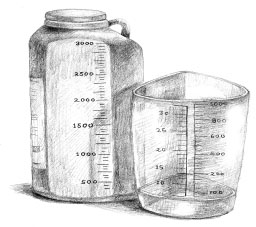

Proteinuria
On this page:
Proteinuria describes a condition in which urine contains an abnormal amount of protein. Proteins are the building blocks for all body parts, including muscles, bones, hair, and nails. Proteins in your blood also perform a number of important functions. They protect you from infection, help your blood clot, and keep the right amount of fluid circulating throughout your body.
As blood passes through healthy kidneys, they filter the waste products out and leave in the things the body needs, like proteins. Most proteins are too big to pass through the kidneys' filters into the urine unless the kidneys are damaged. The main protein that is most likely to appear in urine is albumin. Proteins from the blood can escape into the urine when the filters of the kidney, called glomeruli, are damaged. Sometimes the term albuminuria is used when a urine test detects albumin specifically. Albumin's function in the body includes retention of fluid in the blood. It acts like a sponge, soaking up fluid from body tissues.
Inflammation in the glomeruli is called glomerulonephritis, or simply nephritis. Many diseases can cause this inflammation, which leads to proteinuria. Additional processes that can damage the glomeruli and cause proteinuria include diabetes, hypertension, and other forms of kidney diseases.
Research shows that the level and type of proteinuria (whether the urinary proteins are albumin only or include other proteins) strongly determine the extent of damage and whether you are at risk for developing progressive kidney failure.
Proteinuria is also associated with cardiovascular disease. Damaged blood vessels may lead to heart failure or stroke as well as kidney failure. If your doctor finds that you have proteinuria, do what you can to protect your health and prevent any of these diseases from developing.
Several health organizations recommend that some people be regularly checked for proteinuria so that kidney disease can be detected and treated before it progresses. A 1996 study sponsored by the National Institutes of Health determined that proteinuria is the best predictor of progressive kidney failure in people with type 2 diabetes. The American Diabetes Association recommends regular urine testing for proteinuria for people with type 1 or type 2 diabetes. The National Kidney Foundation recommends that routine checkups include testing for excess protein in the urine, especially for people in high-risk groups.
[Top]
Who is at risk?
People with diabetes, hypertension, or certain family backgrounds are at risk for proteinuria. In the United States, diabetes is the leading cause of end-stage renal disease (ESRD), the result of chronic kidney disease. In both type 1 and type 2 diabetes, the first sign of deteriorating kidney function is the presence of small amounts of albumin in the urine, a condition called microalbuminuria. As kidney function declines, the amount of albumin in the urine increases, and microalbuminuria becomes full-fledged proteinuria.
High blood pressure is the second leading cause of ESRD. Proteinuria in a person with high blood pressure is an indicator of declining kidney function. If the hypertension is not controlled, the person can progress to full renal failure.
African Americans are more likely than Caucasians to have high blood pressure and to develop kidney problems from it, even when their blood pressure is only mildly elevated. In fact, African Americans
are six times more likely than Caucasians to develop hypertension-related kidney failure.
Other groups at risk for proteinuria are American Indians, Hispanic/Latinos, Pacific Islander Americans, older people, and overweight people. These at-risk groups and people who have a family history of kidney disease should have their urine tested regularly.
[Top]
What are the signs of proteinuria and kidney failure?
Large amounts of protein in your urine may cause it to look foamy in the toilet. Also, because the protein has left your body, your blood can no longer soak up enough fluid and you may notice swelling in your hands, feet, abdomen, or face. These are signs of very large protein loss. More commonly, you may have proteinuria without noticing any signs or symptoms. Testing is the only way to find out
how much protein you have in your urine.
[Top]
What are the tests for proteinuria?

Containers for collecting urine.
To test for proteinuria, you will need to give a urine sample. A strip of chemically treated paper will change color when dipped in urine that has too much protein. Laboratory tests that measure exact amounts of protein or albumin in the urine are recommended for people at risk for kidney disease, especially those with diabetes. The protein-to-creatinine or albumin-to-creatinine ratio can be measured on a sample of urine to detect smaller amounts of protein, which can indicate kidney disease. If the laboratory test shows high levels of protein, another test should be done 1 to 2 weeks later. If the second test also shows high levels of protein, you have persistent proteinuria and should have additional tests to evaluate your kidney function.
Your doctor will also test a sample of your blood for creatinine and urea nitrogen. These are waste products that healthy kidneys remove from the blood. High levels of creatinine and urea nitrogen in your blood indicate that kidney function is impaired.
[Top]
How is proteinuria treated?
If you have diabetes, hypertension, or both, the first goal of treatment will be to control your blood glucose and blood pressure. If you have diabetes, you should test your blood glucose often, follow a healthy eating plan, take your medicines, and get plenty of exercise. If you have diabetes and high
blood pressure, your doctor may prescribe a medicine from a class of drugs called ACE (angiotensin-converting enzyme) inhibitors or a similar class called ARBs (angiotensin receptor blockers). These drugs have been found to protect kidney function even more than other drugs that provide the same level of blood pressure control. The American Diabetes Association recommends that people with diabetes
keep their blood pressure below 130/80.
People who have high blood pressure and proteinuria but not diabetes also benefit from taking an ACE inhibitor or ARB. Their blood pressure should be maintained below 130/80. To maintain this target, you may need to take a combination of two or more blood pressure medicines. Your doctor may also prescribe a diuretic in addition to your ACE inhibitor or ARB. Diuretics are also called "water pills" because they help you urinate and get rid of excess fluid in your body.
In addition to blood glucose and blood pressure control, the National Kidney Foundation recommends restricting dietary salt and protein. Your doctor may refer you to a dietitian to help you develop and follow a healthy eating plan.
[Top]
Hope through Research
In recent years, researchers have learned much about kidney disease. The National Institute of Diabetes and Digestive and Kidney Diseases (NIDDK) sponsors several programs aimed at understanding kidney failure and finding treatments to stop its progression.
NIDDK's Division of Kidney, Urologic, and Hematologic Diseases (DKUHD) supports basic research into normal kidney function and the diseases that impair normal function at the cellular and molecular levels, including diabetes, high blood pressure, glomerulonephritis, and other diseases marked by proteinuria.
[Top]
Points to Remember
- Proteinuria is a condition in which urine contains an abnormal amount of protein.
- The term albuminuria is also often used because some tests measure this protein specifically and it is the major type of protein in the urine.
- Proteinuria may be a sign that your kidneys are damaged and that you are at risk for end-stage renal disease.
- Several health organizations recommend that people be regularly checked for proteinuria so that kidney disease can be detected and treated before it progresses.
- Groups at risk for proteinuria and kidney failure include African Americans, American Indians, Hispanic/Latinos, Pacific Islander Americans, people who have diabetes or hypertension, and people who have a family history of kidney disease.
- You may have proteinuria without noticing any signs or symptoms. Testing is the only way to find out how much protein you have in your urine.
- If you have diabetes or hypertension, or both, the first goal of treatment will be to control your blood glucose and blood pressure.
[Top]
For More Information
American Kidney Fund
6110 Executive Boulevard
Suite 1010
Rockville, MD 20852
Phone: 1–800–638–8299 or 301–881–3052
Email: helpline@kidneyfund.org
Internet: www.kidneyfund.org
National Kidney Foundation
30 East 33rd Street
New York, NY 10016
Phone: 1–800–622–9010 or 212–889–2210
Email: info@kidney.org
Internet: www.kidney.org
[Top]
National Kidney and Urologic Diseases Information Clearinghouse
3 Information Way
Bethesda, MD 20892–3580
Phone: 1–800–891–5390
TTY: 1–866–569–1162
Fax: 703–738–4929
Email: nkudic@info.niddk.nih.gov
Internet: www.kidney.niddk.nih.gov
The National Kidney and Urologic Diseases Information Clearinghouse (NKUDIC) is a service of the National Institute of Diabetes and Digestive and Kidney Diseases (NIDDK). The NIDDK is part of the National Institutes of Health of the U.S. Department of Health and Human Services. Established in 1987, the Clearinghouse provides information about diseases of the kidneys and urologic system to people with kidney and urologic disorders and to their families, health care professionals, and the public. The NKUDIC answers inquiries, develops and distributes publications, and works closely with professional and patient organizations and Government agencies to coordinate resources about kidney and urologic diseases.
Publications produced by the Clearinghouse are carefully reviewed by both NIDDK scientists and outside experts. This publication was reviewed by Lee A. Hebert, M.D., Ohio State University.
This publication is not copyrighted. The Clearinghouse encourages users of this publication to duplicate and distribute as many copies as desired.
NIH Publication No. 06–4732
September 2006
[Top]
|






